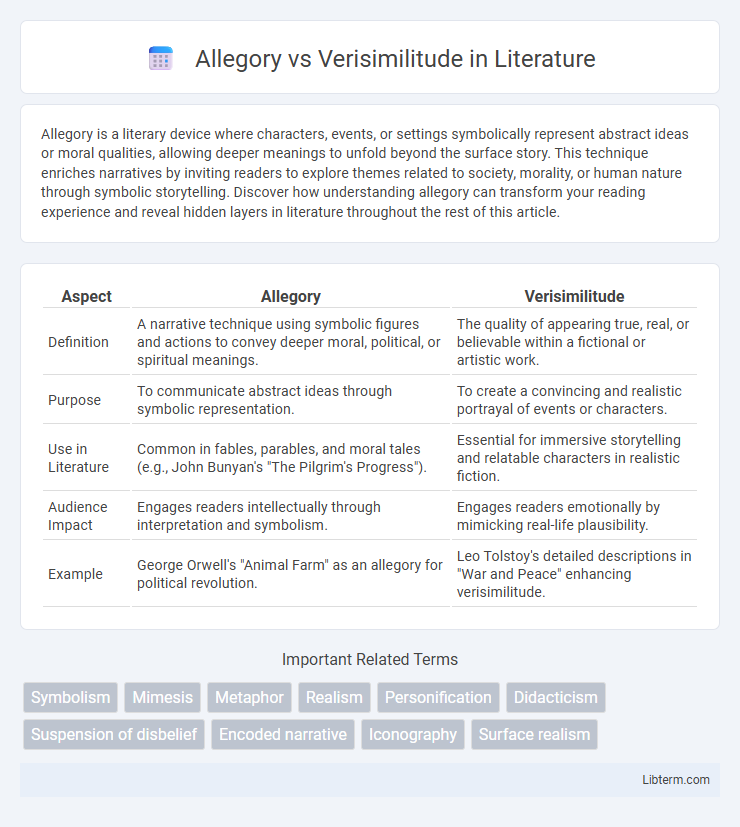Allegory is a literary device where characters, events, or settings symbolically represent abstract ideas or moral qualities, allowing deeper meanings to unfold beyond the surface story. This technique enriches narratives by inviting readers to explore themes related to society, morality, or human nature through symbolic storytelling. Discover how understanding allegory can transform your reading experience and reveal hidden layers in literature throughout the rest of this article.
Table of Comparison
| Aspect | Allegory | Verisimilitude |
|---|---|---|
| Definition | A narrative technique using symbolic figures and actions to convey deeper moral, political, or spiritual meanings. | The quality of appearing true, real, or believable within a fictional or artistic work. |
| Purpose | To communicate abstract ideas through symbolic representation. | To create a convincing and realistic portrayal of events or characters. |
| Use in Literature | Common in fables, parables, and moral tales (e.g., John Bunyan's "The Pilgrim's Progress"). | Essential for immersive storytelling and relatable characters in realistic fiction. |
| Audience Impact | Engages readers intellectually through interpretation and symbolism. | Engages readers emotionally by mimicking real-life plausibility. |
| Example | George Orwell's "Animal Farm" as an allegory for political revolution. | Leo Tolstoy's detailed descriptions in "War and Peace" enhancing verisimilitude. |
Understanding Allegory: Definition and Purpose
Allegory is a narrative technique in literature and art where characters, events, or settings symbolize broader concepts or moral qualities, conveying deeper meanings beyond the literal level. Its purpose is to communicate complex ideas, ethical lessons, or political messages through symbolic representation, creating layered interpretations for the audience. Understanding allegory involves recognizing these symbols and their connections to abstract themes or societal critiques embedded within the work.
What is Verisimilitude? Meaning and Importance
Verisimilitude refers to the appearance of being true or real in literary works, ensuring that characters, settings, and events are believable within the context of the story. It enhances readers' immersion by maintaining consistency and plausibility, making narratives resonate with genuine human experiences. The importance of verisimilitude lies in fostering emotional engagement and suspension of disbelief, crucial for effective storytelling.
Key Differences Between Allegory and Verisimilitude
Allegory conveys abstract ideas or moral qualities through symbolic figures, actions, or imagery, emphasizing meaning beyond the literal level. Verisimilitude focuses on creating a realistic and believable representation of life, ensuring that a narrative's details plausibly mimic real-world conditions. The key difference lies in allegory's intent to illustrate deeper symbolic truths, whereas verisimilitude prioritizes authenticity and credibility in storytelling.
Historical Context: Allegory in Classic Literature
Allegory in classic literature often served as a vehicle for conveying complex moral, religious, and political ideas through symbolic characters and narratives, exemplified by works like John Bunyan's "The Pilgrim's Progress" and Dante Alighieri's "Divine Comedy." This literary device flourished during periods of social upheaval and censorship, allowing authors to critique contemporary issues indirectly while engaging readers in layered interpretation. Historical context reveals allegory's evolution as a powerful tool for philosophical discourse and cultural reflection, contrasting with verisimilitude's emphasis on realistic representation.
Verisimilitude’s Role in Modern Storytelling
Verisimilitude in modern storytelling enhances audience immersion by creating believable and consistent fictional worlds that mirror reality's nuances. It emphasizes plausible character motivations, authentic dialogue, and realistic settings, ensuring stories resonate emotionally and intellectually. This narrative technique bridges the gap between fiction and reality, making the content relatable and impactful for contemporary audiences.
Symbolism and Interpretation in Allegorical Works
Allegory employs symbolism extensively, using characters, events, and settings as metaphors to convey deeper moral, political, or spiritual meanings beyond the literal narrative. Interpretation in allegorical works requires readers to decode these symbolic elements to uncover hidden messages and thematic insights embedded by the author. The layered symbolism in allegories offers a multi-dimensional reading experience, contrasting with verisimilitude's focus on realistic representation and factual accuracy.
Creating Realism: Techniques for Achieving Verisimilitude
Creating realism through verisimilitude involves detailed description, authentic dialogue, and consistent character behavior that mirrors real-life complexity. Unlike allegory, which uses symbolic representation to convey abstract ideas, verisimilitude emphasizes plausible scenarios and believable settings to immerse readers. Techniques such as sensory imagery, cultural specificity, and psychological depth enhance the illusion of reality in narrative fiction.
Blurring the Lines: When Allegory Meets Verisimilitude
Blurring the lines between allegory and verisimilitude creates narratives rich in symbolic depth while maintaining realistic detail, enhancing reader engagement through believable yet meaningful storytelling. Characters and settings in such works often embody abstract concepts yet behave in ways consistent with real-world logic and psychology, bridging imaginative metaphor and authentic experience. This fusion amplifies the impact of themes by grounding allegorical messages within a convincingly realistic framework, inviting deeper interpretation without sacrificing narrative credibility.
Notable Examples: Allegory vs Verisimilitude in Literature
Notable examples of allegory in literature include George Orwell's "Animal Farm," which uses farm animals to represent political figures and critique totalitarianism, and John Bunyan's "The Pilgrim's Progress," a spiritual journey symbolizing Christian salvation. In contrast, verisimilitude is exemplified by works like Gustave Flaubert's "Madame Bovary," where detailed realism creates a convincing depiction of 19th-century provincial life, and Leo Tolstoy's "War and Peace," which portrays historical events with meticulous accuracy to reflect real human experiences. These examples highlight how allegory employs symbolic representation to convey deeper meanings, while verisimilitude focuses on lifelike authenticity to immerse readers in believable settings.
Choosing the Right Approach: Allegory or Verisimilitude
Choosing between allegory and verisimilitude depends on the intended narrative effect and reader engagement. Allegory employs symbolic representation to convey abstract concepts, making it ideal for delivering moral or philosophical themes through layered meaning. Verisimilitude prioritizes realistic detail and credible scenarios to immerse readers, enhancing authenticity and emotional connection in storytelling.
Allegory Infographic

 libterm.com
libterm.com